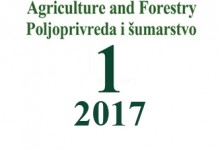Biotechnical Faculty / LIVESTOCK PRODUCTION / SELECTED TOPICS IN MODERN LIVESTOCK
| Course: | SELECTED TOPICS IN MODERN LIVESTOCK/ |
| Course ID | Course status | Semester | ECTS credits | Lessons (Lessons+Exercises+Laboratory) |
| 8102 | Obavezan | 1 | 9 | 4+2+0 |
| Programs | LIVESTOCK PRODUCTION |
| Prerequisites | |
| Aims | |
| Learning outcomes | |
| Lecturer / Teaching assistant | |
| Methodology |
| Plan and program of work | |
| Preparing week | Preparation and registration of the semester |
| I week lectures | |
| I week exercises | |
| II week lectures | |
| II week exercises | |
| III week lectures | |
| III week exercises | |
| IV week lectures | |
| IV week exercises | |
| V week lectures | |
| V week exercises | |
| VI week lectures | |
| VI week exercises | |
| VII week lectures | |
| VII week exercises | |
| VIII week lectures | |
| VIII week exercises | |
| IX week lectures | |
| IX week exercises | |
| X week lectures | |
| X week exercises | |
| XI week lectures | |
| XI week exercises | |
| XII week lectures | |
| XII week exercises | |
| XIII week lectures | |
| XIII week exercises | |
| XIV week lectures | |
| XIV week exercises | |
| XV week lectures | |
| XV week exercises |
| Student workload | |
| Per week | Per semester |
| 9 credits x 40/30=12 hours and 0 minuts
4 sat(a) theoretical classes 0 sat(a) practical classes 2 excercises 6 hour(s) i 0 minuts of independent work, including consultations |
Classes and final exam:
12 hour(s) i 0 minuts x 16 =192 hour(s) i 0 minuts Necessary preparation before the beginning of the semester (administration, registration, certification): 12 hour(s) i 0 minuts x 2 =24 hour(s) i 0 minuts Total workload for the subject: 9 x 30=270 hour(s) Additional work for exam preparation in the preparing exam period, including taking the remedial exam from 0 to 30 hours (remaining time from the first two items to the total load for the item) 54 hour(s) i 0 minuts Workload structure: 192 hour(s) i 0 minuts (cources), 24 hour(s) i 0 minuts (preparation), 54 hour(s) i 0 minuts (additional work) |
| Student obligations | |
| Consultations | |
| Literature | |
| Examination methods | |
| Special remarks | |
| Comment |
| Grade: | F | E | D | C | B | A |
| Number of points | less than 50 points | greater than or equal to 50 points and less than 60 points | greater than or equal to 60 points and less than 70 points | greater than or equal to 70 points and less than 80 points | greater than or equal to 80 points and less than 90 points | greater than or equal to 90 points |
Biotechnical Faculty / LIVESTOCK PRODUCTION / BREEDING AND SELECTION OF FARM ANIMALS
| Course: | BREEDING AND SELECTION OF FARM ANIMALS/ |
| Course ID | Course status | Semester | ECTS credits | Lessons (Lessons+Exercises+Laboratory) |
| 8104 | Izborni | 1 | 9 | 4+2+0 |
| Programs | LIVESTOCK PRODUCTION |
| Prerequisites | Statistics and Genetics |
| Aims | To understand the principles of animal breeding and genetics (Mendelian inheritance, genetics of quantitative traits and population genetics) and their application in the improvement of animals (genetic evaluation of breeding animals, selection and crossbreeding systems, biotechnology applied in animal breeding). |
| Learning outcomes | By the end of the semester, the student should be able to: Be familiar with the concept of inheritance of traits in domestic animals, making a clear distinction between those that are simply inherited (qualitative) and polygenic traits (quantitative). Understand and explain the sources of genetic variability and to formulate a model for quantitative traits. Explain the concept of genetic parameters: heritability, repeatability and genetic correlation and to apply them in calculations of breeding value (BV). Comprehend the principles and the effects of selection, selection differential and intensity, generation interval. Explain the concept and consequences of inbreeding Understand the concept of hybrid vigor and complementarity in different schemes of crossbreeding of domestic animals. Explain the breeding value and the most important methods for its evaluation. as well as benefits of reproductive and molecular biotechnologies applied in animal breeding Explain the components of the breeding program, the structure of breeds, breeding goals. |
| Lecturer / Teaching assistant | Prof. dr Milan Marković mr Miljan Veljić |
| Methodology | Lectures, practical exercises, consultations, colloquiums, homework and term papers. |
| Plan and program of work | |
| Preparing week | Preparation and registration of the semester |
| I week lectures | Introduction to Animal Breeding (importance, history, basic terms and definitions) |
| I week exercises | Revisiting the basis of animal genetic |
| II week lectures | Genetic basis of Animal Breeding (Mendelian principles of inheritance, genes and population, simply-inherited and polygenic traits) |
| II week exercises | Revisiting the basic genetics used in animal breeding |
| III week lectures | Genotype by Environment interaction; Genetic model for Quantitative traits |
| III week exercises | Inheritance of quantitative traits |
| IV week lectures | Variation and sources of genetic variation, statistic and their application to quantitative traits |
| IV week exercises | Analyses of variance |
| V week lectures | Genetic parameters: heritability, repeatability and genetic correlation |
| V week exercises | Methods for estimation of Genetic parameters |
| VI week lectures | Relationship and inbreeding (effects of inbreeding, Calculation of inbreeding and relationship coefficients |
| VI week exercises | Colloquium I |
| VII week lectures | Strategies for genetic improvements of farm animals (selection - principles and responses, crossing) |
| VII week exercises | Calculation of inbreeding and relationship coefficients |
| VIII week lectures | Genetic improvements of animals by crossbreeding (hybrid vigor or heterosis, crossbreeding systems) |
| VIII week exercises | Crossbreeding systems and heterosis |
| IX week lectures | Breed structure and genetic gain (breed definition, traditional breed pyramid, closed and open nucleus and dissemination of genetic gain) |
| IX week exercises | Expected genetic gain in one trait selection |
| X week lectures | Selection methods (individual selection – performance test, family selection, intra family, sib selection, pedigree selection, progeny test, indirect selection, multiple-trait selection) |
| X week exercises | Calculation aspects of Selection indexes |
| XI week lectures | Genetic evaluation – Breeding Value estimation and prediction (BLUP sire model and BLUP Animal model) |
| XI week exercises | Procedure in Breeding values estimation and prediction |
| XII week lectures | Biotechnology and Animal breeding (Reproductive technologies, Molecular technologies, Genomic selection) |
| XII week exercises | Adjustment factors in using performance data in genetic evaluations |
| XIII week lectures | Breeding programs for different species of farm animals |
| XIII week exercises | Colloquium II |
| XIV week lectures | The end or beginning – Common-sense in animal breeding – practical recommendations |
| XIV week exercises | The examples of breeding programs for different species of farm animal |
| XV week lectures | Final exam |
| XV week exercises | Verification of semester and grades |
| Student workload | Weekly 3 + 2 (5) 6 credits x 40/30 = 9 hours Structure: 4 hours of lectures 2 hours of exercises 3 hours of individual work of students (preparation exercises, seminar work) including consultation |
| Per week | Per semester |
| 9 credits x 40/30=12 hours and 0 minuts
4 sat(a) theoretical classes 0 sat(a) practical classes 2 excercises 6 hour(s) i 0 minuts of independent work, including consultations |
Classes and final exam:
12 hour(s) i 0 minuts x 16 =192 hour(s) i 0 minuts Necessary preparation before the beginning of the semester (administration, registration, certification): 12 hour(s) i 0 minuts x 2 =24 hour(s) i 0 minuts Total workload for the subject: 9 x 30=270 hour(s) Additional work for exam preparation in the preparing exam period, including taking the remedial exam from 0 to 30 hours (remaining time from the first two items to the total load for the item) 54 hour(s) i 0 minuts Workload structure: 192 hour(s) i 0 minuts (cources), 24 hour(s) i 0 minuts (preparation), 54 hour(s) i 0 minuts (additional work) |
| Student obligations | Students are obliged to attend classes and exercises and to work both colloquia |
| Consultations | |
| Literature | 1. Vidović, V.: Principi i metodi oplemenjivanja životinja, Poljoprivredni fakultet Novi sad, 2009; 2. Lasley, J.: Genetika poboljšanja stoke, Znanje, Zagreb, 1971. 3. Bourdon, M. R.: Understanding Animal Breeding, Second Edition, Prentice Hall, Upper Saddle River, 2000; including tranlated chapters by M. Marković. 4. Latinović, D.: Populaciona genetika i oplemenjivanje domaćih životinja, Poljoprivredni fakultet, Beograd, 1996. 5. Đedović, R.: Genetika domaćih i gajenih životinja, Praktikum, Poljoprivredni fakultet, Beograd, 2011. |
| Examination methods | - Regular lectures attendance (max. 3 pts), exercises (max. 2 pts), in total up to 5 pts - Homework (max 5 pts) - I Colloquium: (max 20 pts) - II Colloquium: (max 20 pts) - Final exam: (max 50 pts) Threshold for mark E is a cumulative sum of 51 pts (≥50.51) |
| Special remarks | |
| Comment |
| Grade: | F | E | D | C | B | A |
| Number of points | less than 50 points | greater than or equal to 50 points and less than 60 points | greater than or equal to 60 points and less than 70 points | greater than or equal to 70 points and less than 80 points | greater than or equal to 80 points and less than 90 points | greater than or equal to 90 points |
Biotechnical Faculty / LIVESTOCK PRODUCTION / BASIS OF MASTER THESIS
| Course: | BASIS OF MASTER THESIS/ |
| Course ID | Course status | Semester | ECTS credits | Lessons (Lessons+Exercises+Laboratory) |
| 8451 | Obavezan | 1 | 6 | 3+1+0 |
| Programs | LIVESTOCK PRODUCTION |
| Prerequisites | |
| Aims | |
| Learning outcomes | |
| Lecturer / Teaching assistant | |
| Methodology |
| Plan and program of work | |
| Preparing week | Preparation and registration of the semester |
| I week lectures | |
| I week exercises | |
| II week lectures | |
| II week exercises | |
| III week lectures | |
| III week exercises | |
| IV week lectures | |
| IV week exercises | |
| V week lectures | |
| V week exercises | |
| VI week lectures | |
| VI week exercises | |
| VII week lectures | |
| VII week exercises | |
| VIII week lectures | |
| VIII week exercises | |
| IX week lectures | |
| IX week exercises | |
| X week lectures | |
| X week exercises | |
| XI week lectures | |
| XI week exercises | |
| XII week lectures | |
| XII week exercises | |
| XIII week lectures | |
| XIII week exercises | |
| XIV week lectures | |
| XIV week exercises | |
| XV week lectures | |
| XV week exercises |
| Student workload | |
| Per week | Per semester |
| 6 credits x 40/30=8 hours and 0 minuts
3 sat(a) theoretical classes 0 sat(a) practical classes 1 excercises 4 hour(s) i 0 minuts of independent work, including consultations |
Classes and final exam:
8 hour(s) i 0 minuts x 16 =128 hour(s) i 0 minuts Necessary preparation before the beginning of the semester (administration, registration, certification): 8 hour(s) i 0 minuts x 2 =16 hour(s) i 0 minuts Total workload for the subject: 6 x 30=180 hour(s) Additional work for exam preparation in the preparing exam period, including taking the remedial exam from 0 to 30 hours (remaining time from the first two items to the total load for the item) 36 hour(s) i 0 minuts Workload structure: 128 hour(s) i 0 minuts (cources), 16 hour(s) i 0 minuts (preparation), 36 hour(s) i 0 minuts (additional work) |
| Student obligations | |
| Consultations | |
| Literature | |
| Examination methods | |
| Special remarks | |
| Comment |
| Grade: | F | E | D | C | B | A |
| Number of points | less than 50 points | greater than or equal to 50 points and less than 60 points | greater than or equal to 60 points and less than 70 points | greater than or equal to 70 points and less than 80 points | greater than or equal to 80 points and less than 90 points | greater than or equal to 90 points |
Biotechnical Faculty / LIVESTOCK PRODUCTION / MEAT PRODUCTION-STANDARDS IN PROCESSING INDUSTRY
| Course: | MEAT PRODUCTION-STANDARDS IN PROCESSING INDUSTRY/ |
| Course ID | Course status | Semester | ECTS credits | Lessons (Lessons+Exercises+Laboratory) |
| 8454 | Izborni | 1 | 9 | 4+2+0 |
| Programs | LIVESTOCK PRODUCTION |
| Prerequisites | |
| Aims | |
| Learning outcomes | |
| Lecturer / Teaching assistant | |
| Methodology |
| Plan and program of work | |
| Preparing week | Preparation and registration of the semester |
| I week lectures | |
| I week exercises | |
| II week lectures | |
| II week exercises | |
| III week lectures | |
| III week exercises | |
| IV week lectures | |
| IV week exercises | |
| V week lectures | |
| V week exercises | |
| VI week lectures | |
| VI week exercises | |
| VII week lectures | |
| VII week exercises | |
| VIII week lectures | |
| VIII week exercises | |
| IX week lectures | |
| IX week exercises | |
| X week lectures | |
| X week exercises | |
| XI week lectures | |
| XI week exercises | |
| XII week lectures | |
| XII week exercises | |
| XIII week lectures | |
| XIII week exercises | |
| XIV week lectures | |
| XIV week exercises | |
| XV week lectures | |
| XV week exercises |
| Student workload | |
| Per week | Per semester |
| 9 credits x 40/30=12 hours and 0 minuts
4 sat(a) theoretical classes 0 sat(a) practical classes 2 excercises 6 hour(s) i 0 minuts of independent work, including consultations |
Classes and final exam:
12 hour(s) i 0 minuts x 16 =192 hour(s) i 0 minuts Necessary preparation before the beginning of the semester (administration, registration, certification): 12 hour(s) i 0 minuts x 2 =24 hour(s) i 0 minuts Total workload for the subject: 9 x 30=270 hour(s) Additional work for exam preparation in the preparing exam period, including taking the remedial exam from 0 to 30 hours (remaining time from the first two items to the total load for the item) 54 hour(s) i 0 minuts Workload structure: 192 hour(s) i 0 minuts (cources), 24 hour(s) i 0 minuts (preparation), 54 hour(s) i 0 minuts (additional work) |
| Student obligations | |
| Consultations | |
| Literature | |
| Examination methods | |
| Special remarks | |
| Comment |
| Grade: | F | E | D | C | B | A |
| Number of points | less than 50 points | greater than or equal to 50 points and less than 60 points | greater than or equal to 60 points and less than 70 points | greater than or equal to 70 points and less than 80 points | greater than or equal to 80 points and less than 90 points | greater than or equal to 90 points |
Biotechnical Faculty / LIVESTOCK PRODUCTION / FUNCTIONAL DAIRY PRODUCTS
| Course: | FUNCTIONAL DAIRY PRODUCTS/ |
| Course ID | Course status | Semester | ECTS credits | Lessons (Lessons+Exercises+Laboratory) |
| 8455 | Izborni | 1 | 9 | 4+2+0 |
| Programs | LIVESTOCK PRODUCTION |
| Prerequisites | No conditionality |
| Aims | Introduce students to the concept and classification of functional dairy products, their benefit to human health, the impact of the allergens, strengthen the immune system, the therapeutic use of probiotics, the most important probiotics in dairy industry, the concept of probiotics, prebiotics, and symbiotics, development of probiotic products, market functional dairy products. |
| Learning outcomes | • Perform the classification of functional foods, • Understand and explain the differences between probiotics, prebiotics and symbiotics used in functional food, • Realizes importance of the development of functional foods and its perspectives, • Understand and explain the impact of functional dairy products on human diseases (cancer, cardio-vascular and gastro-intestinal diseases, osteoporosis, allergies ...) • Classifies, briefly describe and explain the impact and benefits of micro-organisms of the intestinal tract that are used in the production of functional products, • Briefly describe the probiotic dairy products and their technology, and maintenance of probiotic microorganisms in milk products, • Use their knowledge in facilities for production of functional dairy products. |
| Lecturer / Teaching assistant | prof. dr Slavko Mirecki, mr Olga Kopitović |
| Methodology | lectures, practice, seminar paper on a given topic, consultations |
| Plan and program of work | |
| Preparing week | Preparation and registration of the semester |
| I week lectures | The definition of functional foods, functional food development throughout history. The definition and classification of functional dairy products |
| I week exercises | Examples of functional food: milk-based products, meat, vegetables, fruits, cereals ... |
| II week lectures | The definition of probiotics. Historical development of probiotics and probiotic food. Probiotic, prebiotic and symbiotic. Classification of probiotic products. |
| II week exercises | Examples of probiotics, prebiotics and symbiotics in the dairy industry |
| III week lectures | The properties of probiotics. The use of probiotics in agriculture and nutrition. |
| III week exercises | The benefits of the use of probiotics for human health, animals and plants. |
| IV week lectures | The mechanism of activities of probiotics. The technology of production of probiotics. |
| IV week exercises | Mechanisms of anticarcinogenicity and antigenotoxicity for probiotics and prebiotics |
| V week lectures | Safety of probiotics and probiotic foods |
| V week exercises | Colloquium 1 (remedial after 15 days) |
| VI week lectures | Biotechnological aspects in the selection of probiotic microorganisms |
| VI week exercises | Selection and quantification of probiotics. Scaning types, insulation, conservation, methods of storage, production of biomass of probiotics, |
| VII week lectures | Functional dairy probiotic products: fermented dairy drinks (yogurt, kefir, koumiss), cheese, ice cream, frozen dairy desserts ... Trends, concept development and attitude of consumers towards these products. |
| VII week exercises | The functional components of dairy products: kazeinofosfopeptidi, oligosaccharides, conjugated linoleic acid, lactic acid bacteria ... |
| VIII week lectures | The benefits of functional dairy products on human health and the impact on osteoporosis, allergies, cancer, heart disease and autoimmune diseases |
| VIII week exercises | Examples of the effects of the use of probiotics, prebiotics and symbiotics on cardiovascular disease |
| IX week lectures | The microorganisms of the digestive tract. |
| IX week exercises | Examples of modifying microorganisms of the digestive tract and their application in practice |
| X week lectures | Impacts, benefits and mechanism of action of gastrointestinal microflora on the digestive tract diseases. |
| X week exercises | Colloquium 2 (remedial after 15 days) |
| XI week lectures | Lactose intolerance and products with a reduced lactose content. The term, causes and treatment of lactose intolerance. |
| XI week exercises | |
| XII week lectures | The challenges and constraints in the development of probiotic products, factors that limit the use of probiotics |
| XII week exercises | Tolerance of probiotic microorganisms to the salt content, pH and the presence of gastric juices as limiting factors for growth. |
| XIII week lectures | Techniques of addition, protection and maintenance of probiotic microorganisms and bioactive components in milk products. |
| XIII week exercises | Application of techniques: encapsulation of probiotic live cells, spray drying, spray cooling, agglomeration, coating, dispersion techniques, extrusion ... |
| XIV week lectures | Future directions of development of functional dairy products. The development of new probiotic products. Isolation of new probiotic microorganisms. Symbiotic relationships probiotic microorganisms. Resistance to antibiotics. |
| XIV week exercises | Overview of new probiotic products: yogurt, organic yogurt, meat products, bakery products, fruits and vegetables, juices ... |
| XV week lectures | Laws & regulations on probiotic products: the situation in the EU, USA, Japan, the Codex Alimentarius. |
| XV week exercises | Attitudes of of FAO / WHO, USA, EU, Japan, Canada ... of probiotic products from the standpoint of regulatory acts |
| Student workload | |
| Per week | Per semester |
| 9 credits x 40/30=12 hours and 0 minuts
4 sat(a) theoretical classes 0 sat(a) practical classes 2 excercises 6 hour(s) i 0 minuts of independent work, including consultations |
Classes and final exam:
12 hour(s) i 0 minuts x 16 =192 hour(s) i 0 minuts Necessary preparation before the beginning of the semester (administration, registration, certification): 12 hour(s) i 0 minuts x 2 =24 hour(s) i 0 minuts Total workload for the subject: 9 x 30=270 hour(s) Additional work for exam preparation in the preparing exam period, including taking the remedial exam from 0 to 30 hours (remaining time from the first two items to the total load for the item) 54 hour(s) i 0 minuts Workload structure: 192 hour(s) i 0 minuts (cources), 24 hour(s) i 0 minuts (preparation), 54 hour(s) i 0 minuts (additional work) |
| Student obligations | the presence on practice, writing the seminar paper, colloquium exams, final exam |
| Consultations | 2 hours during the week |
| Literature | Recomended literature ’’Functional Dairy Products’’, edited by Tiina Mattila-Sandholm and Maria Saarela, Woodhead Publishing Limited, (2003). ’’Probiotics – Biology, Genetics and Health Aspects’’, editor Min-Tze Liong, Springer, (2011) ’’Probiotics’’, |
| Examination methods | - Activities during the classes (0-5 points) - Activity in practice (0-5 points) - Seminar (0-5 points) - First colloquium (0-20 points) - Second colloquium (0-20 points) - Final exam (0-45 points) Passing grade gets the cumulatively collected 50 po |
| Special remarks | Teaching (L + P) is performed for a group of 5 and more students. .Lessons and practice for groups of 4 or less students will be conducted as a mentorship teaching. |
| Comment |
| Grade: | F | E | D | C | B | A |
| Number of points | less than 50 points | greater than or equal to 50 points and less than 60 points | greater than or equal to 60 points and less than 70 points | greater than or equal to 70 points and less than 80 points | greater than or equal to 80 points and less than 90 points | greater than or equal to 90 points |
Biotechnical Faculty / LIVESTOCK PRODUCTION / LIVESTOCK AND RENEWABLE ENERGY
| Course: | LIVESTOCK AND RENEWABLE ENERGY/ |
| Course ID | Course status | Semester | ECTS credits | Lessons (Lessons+Exercises+Laboratory) |
| 9704 | Izborni | 2 | 6 | 3+1+0 |
| Programs | LIVESTOCK PRODUCTION |
| Prerequisites | |
| Aims | |
| Learning outcomes | |
| Lecturer / Teaching assistant | |
| Methodology |
| Plan and program of work | |
| Preparing week | Preparation and registration of the semester |
| I week lectures | |
| I week exercises | |
| II week lectures | |
| II week exercises | |
| III week lectures | |
| III week exercises | |
| IV week lectures | |
| IV week exercises | |
| V week lectures | |
| V week exercises | |
| VI week lectures | |
| VI week exercises | |
| VII week lectures | |
| VII week exercises | |
| VIII week lectures | |
| VIII week exercises | |
| IX week lectures | |
| IX week exercises | |
| X week lectures | |
| X week exercises | |
| XI week lectures | |
| XI week exercises | |
| XII week lectures | |
| XII week exercises | |
| XIII week lectures | |
| XIII week exercises | |
| XIV week lectures | |
| XIV week exercises | |
| XV week lectures | |
| XV week exercises |
| Student workload | |
| Per week | Per semester |
| 6 credits x 40/30=8 hours and 0 minuts
3 sat(a) theoretical classes 0 sat(a) practical classes 1 excercises 4 hour(s) i 0 minuts of independent work, including consultations |
Classes and final exam:
8 hour(s) i 0 minuts x 16 =128 hour(s) i 0 minuts Necessary preparation before the beginning of the semester (administration, registration, certification): 8 hour(s) i 0 minuts x 2 =16 hour(s) i 0 minuts Total workload for the subject: 6 x 30=180 hour(s) Additional work for exam preparation in the preparing exam period, including taking the remedial exam from 0 to 30 hours (remaining time from the first two items to the total load for the item) 36 hour(s) i 0 minuts Workload structure: 128 hour(s) i 0 minuts (cources), 16 hour(s) i 0 minuts (preparation), 36 hour(s) i 0 minuts (additional work) |
| Student obligations | |
| Consultations | |
| Literature | |
| Examination methods | |
| Special remarks | |
| Comment |
| Grade: | F | E | D | C | B | A |
| Number of points | less than 50 points | greater than or equal to 50 points and less than 60 points | greater than or equal to 60 points and less than 70 points | greater than or equal to 70 points and less than 80 points | greater than or equal to 80 points and less than 90 points | greater than or equal to 90 points |











